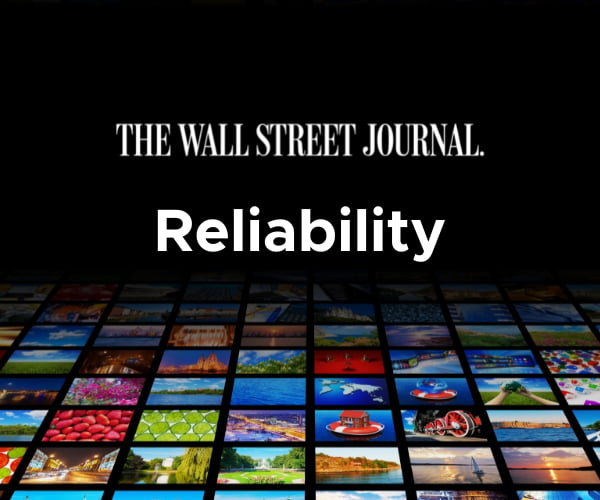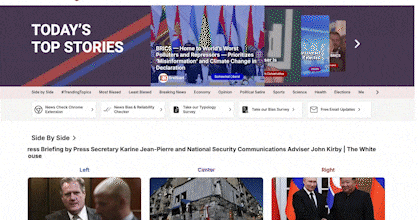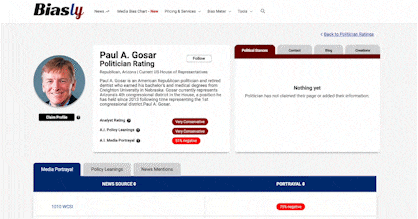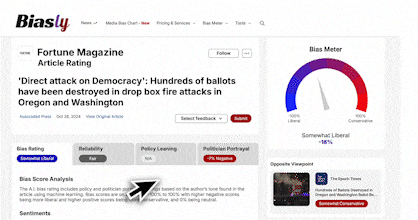
(updated 6-2-2023)
In 2018, a survey of the public by Gallup and the Knight Foundation found the Wall Street Journal (WSJ) to be the third-most accurate news organization among 38 other well-known companies. The poll results revealed that only 10% of participants felt WSJ reporting was “not very” or “not at all accurate,” while a staggering 42% said it was “very” or “extremely accurate.” Forbes also named the WSJ as the top among the most trustworthy media brands.
Despite its reputation, however, the paper is not infallible, and it has been known to publish inaccurate information and has also been called out for its sometimes-inadequate fact-checking. At Biasly, we strive to determine the reliability and accuracy of all media companies, and we’re here to set the record straight — is the WSJ really as reliable as the public perceives it to be? Let’s find out.
Does Reliability Matter?
Reliability, in general, refers to how trustworthy or accurate information, or in this case, a news source is. If we consider this definition, it quickly becomes clear why reliability is important in media sources. If we can’t trust the things we read then there isn’t much of a point in continuing to consume content from that source, after all. So how exactly can we gauge the reliability of a news source anyways?
There are several potential measures of reliability to look out for when trying to determine whether a media source is reliable or not. Red flags for an unreliable article can include the presence of wild unsubstantiated claims, facts dependent on other unreliable sources, heavy use of opinionated language, and more. Some indicators of a reliable news source, on the other hand, include things like:
- Absence of subjective/opinionated language in articles
- Credible sources cited (e.g., neutral sources, .gov, .edu websites)
- Facts and statistics backed by multiple relevant outside sources
- Use of primary sources when possible (e.g., interviews, quotes)
- Information that remains consistent across news sources
So How Does the WSJ Fare in its Reliability?
The political reliability index developed by Biasly objectively assesses news organizations’ accuracy and trustworthiness. The Wall Street Journal’s overall Reliability Score has been rated as ‘Good’ by Biasly. This rating is a weighted average of two distinct scores: the Fact Analysis Score and the Source Analysis Score, each evaluating separate components of The Wall Street Journal’s Reliability. When computing the Average Reliability of the article the Fact Analysis score is more heavily weighted. These ratings are as follows in the next two paragraphs:
The Wall Street Journal’s Fact Analysis Score is ‘Excellent,’ which suggests readers can trust almost all of The Wall Street Journal’s content online. The Fact Analysis score focuses more on the accuracy of claims, facts, and sources presented in the article and any hints of selection and omission bias, which we will discuss further in the article.
The Wall Street Journal’s Source Analysis Score is ‘Poor,’ which suggests readers can trust few of the sources, links, and quotes provided by the news source. This score, which is based on A.I., focuses on assessing the quality of sources and quotes used including their number, lengths, uniqueness, and diversity.
However, since these scores are based on percentages and averages, individual articles could be more or less trustworthy depending on the context, author, and other factors. Our findings show that The Wall Street Journal’s reliability is mostly but not all factual because they have retracted several stories in the past or had pieces that were not factual.
Let us analyze the supporting data for The Wall Street Journal’s rankings and discuss what to watch out for while searching for trustworthy news sources.
WSJ Accuracy and Reliability
Bias and political leanings play a significant part in a news company’s reliability. The WSJ, like countless other media outlets, is occasionally said to prioritize the conservative agenda at the expense of facts. We can find out if this is really true by assessing the accuracy of WSJ news articles and determining how well the organization backs up claims with facts. As we evaluate the accuracy and factuality of their articles, we’ll be looking for selection and omission bias.
Selection bias is when stories and facts are selected or deselected, often on ideological grounds, to create a narrative in support of the new sources’ ideology. Omission bias, on the other hand, is when different opinions and political views regarding a situation are left out so that the reader is only exposed to the ideological perspective supported by the author. It’s important to keep in mind these two types of biases when trying to assess an article’s level of accuracy.
Biasly rates accuracy on a percentage scale of 1-100, with 1 being the least accurate and 100 the most accurate. Ratings are determined by measuring claims with factually-backed reasoning, credible sources, and the number of credible external sources used within an article. As we mentioned, the WSJ has excellent accuracy on average in terms of reliability, based on the articles analysts have rated. For comparison, the WSJ’s major competitor, the Washington Post, received a “Good” reliable score from Biasly and a factual reporting score of “Mostly Factual” on Media Bias/Fact Check (MBFC). Both publications also share an MBFC credibility rating of High. Overall, the two competitors are similarly reliable with opposing biases, with the Wall Street Journal leaning right and the Washington Post leaning left.
Biasly’s website has an entire page that provides reliability and accuracy ratings for recently published WSJ articles. For example, an article entitled “Biden’s Student-Debt Pledge Stalls, Frustrating Supporters” was rated as somewhat liberal. In terms of selection and omission bias, the authors of this article are very good at pulling sources from both sides of the aisle — quoting students who support student debt relief, liberal politicians like Elizabeth Warren, and conservative Trump-supporting figures who do not support the proposition. They include conservative skepticism as well as liberal hope about student loan relief; the 12 quotes are of moderate length and provide insights into the emotional and financial toll of student debt. There is an excellent balance of sources, quantitative and qualitative, including student debt figures, public polls, and so forth. What’s more, it doesn’t smear either side of the aisle. This article can be considered mostly reliable.
In terms of the number of different sources used, the article primarily relies on the statements and viewpoints of individuals with student debt with infrequent citations from the Biden administration, the Trump administration, the Department of Education, the Brookings Institution, the law and liberal legal scholars, public polls, and Senator Elizabeth Warren — with most of these being liberal. Regarding the quality of the facts used in the article, most of the information appears to be accurate and supported by data; the article states that Americans owe around $1.6 trillion in federal student loans and over $130 billion in private student loans, according to the data firm MeasureOne. The figures provided are plausible and align with commonly reported statistics on student loan debt. Additionally, the article mentions a January poll that found 49% of the public supports forgiving student loan debt from public colleges and universities, while 35% are opposed, which is supported by a 2022 poll by The Economist/YouGov.
The rest of the information presented in the article is either anecdotal accounts from individuals or general statements without specific factual claims that can be evaluated for accuracy. The article primarily focuses on conveying personal experiences and perspectives on student debt rather than relying heavily on statistical data or studies. Therefore, the issue of poorly sourced facts is not prevalent in this particular article. However, it is unclear in what context Senator Warren provided the following quote and why she feels this way about Biden canceling the student debt, which constitutes a poorly sourced quote:
“‘He must do this,’ Sen. Elizabeth Warren (D., Mass.) said. ‘It’s the right thing for generational equality; it’s the right thing for racial equality; and it’s the right thing for strengthening our economic future.’”
We’ll cover more examples like this below, providing further analysis with examples of the WSJ’s reliability, including its use of selection and omission bias and the quality of sources and facts used.
Analysis of Reliability in WSJ Opinion Pieces
Although excessive opinion can be something to avoid when writing a general news article, opinion-style journalism is an appropriate place for reporters to state their views and beliefs. Even though opinion articles are less reliable due to their subjective nature, they can still be worth reading for the sake of broadening one’s understanding of various viewpoints across the political spectrum.
WSJ’s opinions have had some problems with reliability in their tendency to promote right-wing causes and individuals; the organization has been involved in several controversies wherein they were accused of low scientific credibility and of rejecting the consensus of climate scientists by treating climate science as opinion. Specifically, they were said to have published inaccurate claims about climate change’s effect on ice melt, the science of the ocean levels rising, and economic consequences of climate change. Their commitment to the anti-climate-science narrative may come at the expense of their liberal readership and overall trustworthiness.
Quality of Sources and Facts Used
The WSJ is generally good at using high-quality sources from both sides of the political spectrum and citing facts as evidence, but this isn’t the case for every article. For example, consider “Republican Party: Make Trump tax cuts permanent.” The authors’ selection of sources focuses exclusively on how people in all tax brackets have had to pay fewer taxes, which they consider to be a good thing, focusing exclusively on the benefits of tax cuts. They do not account for the leftist perspective; the left favors a large government safety net and taxpayer-funded public services, which are usually among the first things to be cut back when tax cuts are made. They often see tax cuts as favoring the rich and limiting the availability of public goods and welfare.
In this article, the writer cites a related WSJ article and a Scott Rasmussen poll, which leans conservative. Liberal Treasury Secretary Janet Yellen is paraphrased, but they are used to make a right-wing point, and there is no link to her statement to verify her meaning in the broader context. The evidence, therefore, is conservative-leaning.
Furthermore, the author cites the effects of the Trump tax cuts and explains the misconception that the tax cuts were only for the rich, putting forth statistics that the wages of the lowest 10% of earners grew by 8% while the wages of the top 10% only grew by 5%. The facts could certainly have been stronger, though, if the author had cited the source of this data. In this context, the reader has no choice but to take the author’s word for it.
In a more severe case regarding factuality, an article called “The Climate Snow Job” was analyzed by 10 scientists who determined its credibility to be very low due to the author’s distortion of the facts. The author provided evidence to support several debunked and unsubstantiated claims.
For example, the following statement was ruled false: “Without El Niño, temperatures in 2015 would have been typical of the post-1998 regime.” Scientists said that the El Niño event in question only contributed a few tenths of a degree to the record temperatures recorded in 2015 worldwide and that the author wanted readers to believe the increase in global temperature is normal. The scientists end their analysis, stating, “The Wall Street Journal promises potential subscribers to help them ‘make better-informed decisions’ by providing them with ‘expert commentary and insight’. This op-ed piece is at odds with that ambition.”
Selection and Omission Bias
We noted earlier that the WSJ has demonstrated reliability problems when it comes to climate. One article from 2018 is another good example of this, illustrating selection and omission bias in particular. In an article entitled “The Sea Is Rising, but Not Because of Climate Change,” author Fred Singer says that warming does not impact the rise of sea levels. As it turns out, Singer cherry-picked the date range of 1915 and 1945 to display sea levels and used a single study from 1990 on which to base his conclusions. He ignored the widely available data that has been published since, which indicates that sea level rise is accelerating as a result of human-caused warming.
In a separate article, “About Those Non-Disappearing Pacific Islands,” another author failed to provide all the information necessary to build a strong case for his argument. The article states that Pacific islands aren’t shrinking along with sea levels rising because natural processes move sediment to expand the shoreline. What it leaves out, however, is that sea level rise related to climate change would make many Pacific islands uninhabitable; climate researchers determined that the author’s cited research was cherry-picked and applied too broadly. Overall, the author was accused of stringing together a misleading picture based on errors of omission, selective reporting, and half-truths.
The problems with factuality, sources, and selection and omission tend to be common in opinion articles like these. The ones we’ve discussed above are largely one-sided and exclude facts and valuable context that don’t work in favor of the author’s argument. As a slightly conservative-leaning news source, the WSJ has a minor incentive to continue playing to conservative views to keep its large right-leaning reader base engaged. But now that we’ve summarized common reliability indicators, you can keep yourself up to date on the latest, most accurate news.
So Is the WSJ Reliable?
Ultimately, the WSJ is a very reputable and reliable source with a strong positive reputation of journalistic integrity with some outlier cases, so it could be said that the accuracy of its articles varies. The more you study the topic of media reliability, the easier it will become for you to identify issues with factuality, sources, and selection and omission. Until then, you can use Biasly’s News Bias Checker to uncover reliability issues and help you find the most accurate and trustworthy news.

























